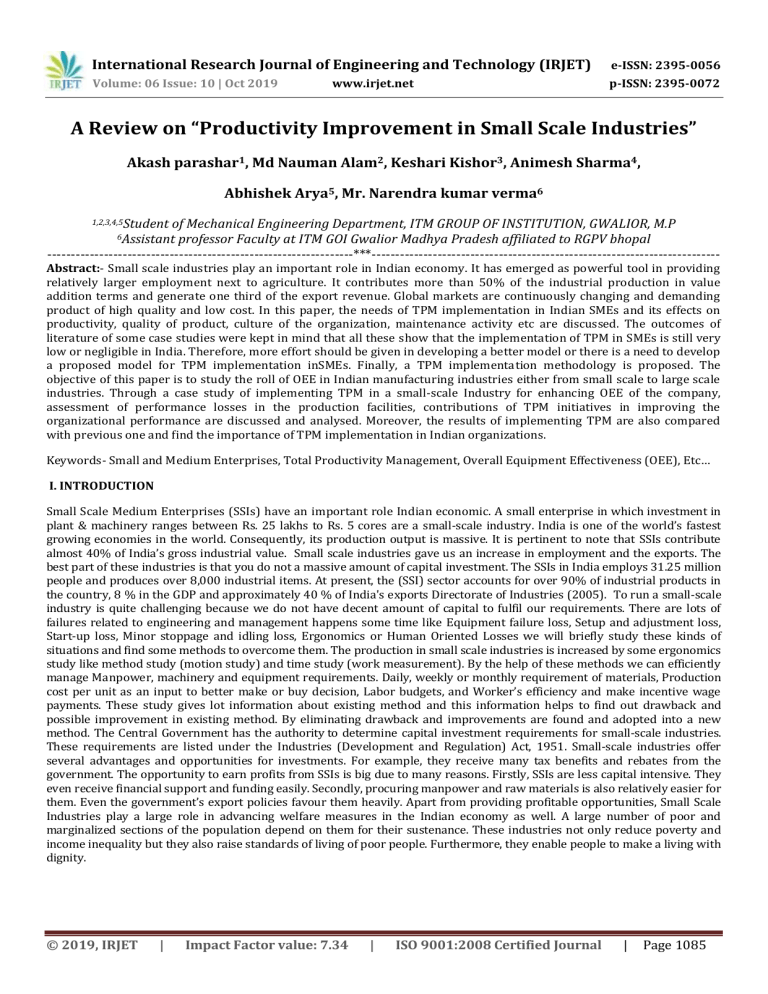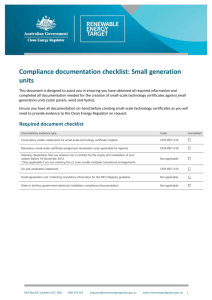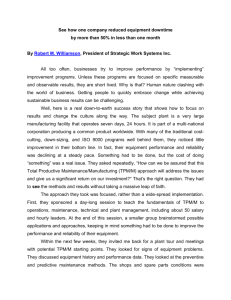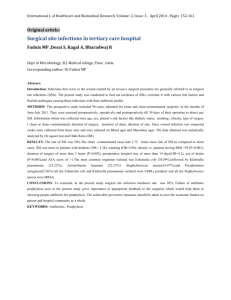IRJET-A Review on “Productivity Improvement in Small Scale Industries”
advertisement

International Research Journal of Engineering and Technology (IRJET) e-ISSN: 2395-0056 Volume: 06 Issue: 10 | Oct 2019 p-ISSN: 2395-0072 www.irjet.net A Review on “Productivity Improvement in Small Scale Industries” Akash parashar1, Md Nauman Alam2, Keshari Kishor3, Animesh Sharma4, Abhishek Arya5, Mr. Narendra kumar verma6 1,2,3,4,5Student of Mechanical Engineering Department, ITM GROUP OF INSTITUTION, GWALIOR, M.P professor Faculty at ITM GOI Gwalior Madhya Pradesh affiliated to RGPV bhopal -----------------------------------------------------------------***-------------------------------------------------------------------------6Assistant Abstract:- Small scale industries play an important role in Indian economy. It has emerged as powerful tool in providing relatively larger employment next to agriculture. It contributes more than 50% of the industrial production in value addition terms and generate one third of the export revenue. Global markets are continuously changing and demanding product of high quality and low cost. In this paper, the needs of TPM implementation in Indian SMEs and its effects on productivity, quality of product, culture of the organization, maintenance activity etc are discussed. The outcomes of literature of some case studies were kept in mind that all these show that the implementation of TPM in SMEs is still very low or negligible in India. Therefore, more effort should be given in developing a better model or there is a need to develop a proposed model for TPM implementation inSMEs. Finally, a TPM implementation methodology is proposed. The objective of this paper is to study the roll of OEE in Indian manufacturing industries either from small scale to large scale industries. Through a case study of implementing TPM in a small-scale Industry for enhancing OEE of the company, assessment of performance losses in the production facilities, contributions of TPM initiatives in improving the organizational performance are discussed and analysed. Moreover, the results of implementing TPM are also compared with previous one and find the importance of TPM implementation in Indian organizations. Keywords- Small and Medium Enterprises, Total Productivity Management, Overall Equipment Effectiveness (OEE), Etc… I. INTRODUCTION Small Scale Medium Enterprises (SSIs) have an important role Indian economic. A small enterprise in which investment in plant & machinery ranges between Rs. 25 lakhs to Rs. 5 cores are a small-scale industry. India is one of the world’s fastest growing economies in the world. Consequently, its production output is massive. It is pertinent to note that SSIs contribute almost 40% of India’s gross industrial value. Small scale industries gave us an increase in employment and the exports. The best part of these industries is that you do not a massive amount of capital investment. The SSIs in India employs 31.25 million people and produces over 8,000 industrial items. At present, the (SSI) sector accounts for over 90% of industrial products in the country, 8 % in the GDP and approximately 40 % of India's exports Directorate of Industries (2005). To run a small-scale industry is quite challenging because we do not have decent amount of capital to fulfil our requirements. There are lots of failures related to engineering and management happens some time like Equipment failure loss, Setup and adjustment loss, Start-up loss, Minor stoppage and idling loss, Ergonomics or Human Oriented Losses we will briefly study these kinds of situations and find some methods to overcome them. The production in small scale industries is increased by some ergonomics study like method study (motion study) and time study (work measurement). By the help of these methods we can efficiently manage Manpower, machinery and equipment requirements. Daily, weekly or monthly requirement of materials, Production cost per unit as an input to better make or buy decision, Labor budgets, and Worker’s efficiency and make incentive wage payments. These study gives lot information about existing method and this information helps to find out drawback and possible improvement in existing method. By eliminating drawback and improvements are found and adopted into a new method. The Central Government has the authority to determine capital investment requirements for small-scale industries. These requirements are listed under the Industries (Development and Regulation) Act, 1951. Small-scale industries offer several advantages and opportunities for investments. For example, they receive many tax benefits and rebates from the government. The opportunity to earn profits from SSIs is big due to many reasons. Firstly, SSIs are less capital intensive. They even receive financial support and funding easily. Secondly, procuring manpower and raw materials is also relatively easier for them. Even the government’s export policies favour them heavily. Apart from providing profitable opportunities, Small Scale Industries play a large role in advancing welfare measures in the Indian economy as well. A large number of poor and marginalized sections of the population depend on them for their sustenance. These industries not only reduce poverty and income inequality but they also raise standards of living of poor people. Furthermore, they enable people to make a living with dignity. © 2019, IRJET | Impact Factor value: 7.34 | ISO 9001:2008 Certified Journal | Page 1085 International Research Journal of Engineering and Technology (IRJET) e-ISSN: 2395-0056 Volume: 06 Issue: 10 | Oct 2019 p-ISSN: 2395-0072 www.irjet.net II. STUDY OBJECTIVE Mainly in following objective of work study is given increase efficiency of productivity, better product quality, to choose the fastest method to do job, to improve the working process, less fatigue to operators and workers, efficiency labour control, effective utilisation of resources, to decide equipment requirement, to pay fair wages, to aid in calculating exact delivery, to decide the required manpower to do a job. The main thing here is study the roll of OEE in Indian manufacturing industries either from small scale to large scale industries and to analyse about implementing TPM in a small-scale Industry for enhancing OEE of the company, assessment of performance losses in the production facilities, contributions of TPM initiatives in improving the organizational performance. Primarily it is the awareness of SSI units about the importance of productivity, its measurement and improvement and to study the role of incentives, in general, and of financial incentives, in particular, in productivity improvement. Secondarily it is to study the common practices of SSI units regarding payment of wages and incentives to the workers and to study the trends of labour productivity in SSI units and to propose suggestions for productivity enhancement in SSI units. III. LITERATURE REVIEW The tools and techniques employed in steel foundry industry vary in literature. In addition, literature provides little information regarding the implementation of end solutions in industry. This study also provides details regarding the methods to implement those tools in research work, while providing particulars about related research in literature. “To Improve Productivity by Using Work Study & Design a Fixture in Small Scale Industry". Furthermore, he uses the Pro-E model software for model testing and developing a new model. Reducing Manufacturing Cycle Time of Milk Tanks by Work Study Technique in Small Scale Fabrication Industry.” Work study techniques are expensive to implement in small-scale industries. However, this method gives better results than any other technique. These techniques not only help reduce the cycle time, but also have proved useful in numerous other departments in industry such as inventory control, productivity, quality, labour work, and at various machines in a machine shop to develop process variation. S. Krishna Kumari [1], modified the cellular layout .after this implementation Industry is increased with less inventory, Less Space in Material Movement, Reduction in total number of Machines, Less Number of Operators to meet the varying demand. Dewi Kurniawati [2].They introduced DEMATEL in Indonesian market it helps in identify complex relationships and build a network structure among the factors. Shantideo Gujar1, Dr. Achal S. Shahare2 [3], the objective of their research is to Reduced machine idle time. Increase productivity. Reduce worker’s fatigue, Eliminate wasteful efforts, as well as useless handling material. Sai Nishanth Reddy, P. Srinath Rao and Rajyalakshmi G, [4], they determine on the basis of time and study analysis they did the calculation of assembly line to get the full potential of workers Ms.Vanipriya.R , Dr.D.Venkatramaraju [8] dr.venkatramaraju emphasis on Establishment of such industries in rural areas and small towns helps to check the influx of population into bigger towns. A rewarding feature of economic development in India has been the impressive growth of modern small scale industries. IV. METHODOLOGY The nature of the present research work suggests a hybrid design of research. Exploratory approach is found appropriate for studying the first objective, descriptive for the next two objectives, and causal type of research for the fourth objective. The last objective is studied on the basis of findings, as well as the researcher's own judgement and observations. In view of the need and objectives of the study the questionnaire contained 43 questions designed to gather information regarding the concept and practices of SSIs related to productivity management. As a part of pilot study, the questionnaires were distributed personally in Aligarh to the owners of few SSI units. After completing the pilot study, questionnaires were distributed to various units through either the friends or relatives identified for the purpose or personality where direct approach was possible. In all, 150 units were contacted out of which 93 responded to the questionnaire. The analysis in this study combines Decision Making Trial and Laboratory and Analytic Network (ANP) as a hybrid MCDM model for evaluating and improving problems related to SMEs performance. A hybrid MCDM is not only dealing with problems of interdependence factors and feedback but also improves the normalized Super matrix to suit the real world. The correspondences employed for answering the questionnaire are experts in a related field. The ANP method was used to determine the factors relative weights. The ANP includes all relevant factors and Decision-making alternatives to form a network that incorporates feedback and interdependent relationships. Because of the interdependency, the factors that are less important individually might turn out to be more important when evaluated collectively. © 2019, IRJET | Impact Factor value: 7.34 | ISO 9001:2008 Certified Journal | Page 1086 International Research Journal of Engineering and Technology (IRJET) e-ISSN: 2395-0056 Volume: 06 Issue: 10 | Oct 2019 p-ISSN: 2395-0072 www.irjet.net V. CASE STUDY Small scale industries (SSI) are those industries in which manufacture providing service production are done on small scale or micro scale. For example. These are ideas of small industries napkins, tissue toothpick, water bottle, small toy paper, pen.Case study through reports of past to create more employment opportunities to help develop the rural end less developed regions of economy to reduce optimum utilisation of unexploited resources of the country To improve the standard of living of people. VI. RESULT It improves the growth of the country by increasing urban and rural growth. The industry sector in which the production of goods is a segment of the economy. Potential for large employment small scale industries have potential to create employment opportunities on a massive scale. Requirement of less capital. Contribution to industrial output. Earning forging exchange. Equitable distribution. VII. CONCLUSION Work study gives lot information about existing method and this information helps to find out drawback and possible improvement in existing method. Effective management requires leadership plus administrative skills in Planning organizing, directing and controlling the entire business Operations. Because of limited financial resources and inability to hire Professional managerial personnel, small-scale units lack specialization in the execution of various functions of management. The majority of small-scale units are sole proprietorship organizations and as such these units are highly personal in nature, i.e., the single man's show. It is very difficult to take quick decisions in all respects and implementing these decisions promptly since the sole proprietor is neither a production-oriented engineer nor sales-oriented merchant. He has no time to look after other functions. Moreover, the majority of sole proprietors is illiterate or has low level of education and lack managerial skills. They also do not possess the qualities like motivation, sense of commitment and business morality. Consequently, the small-scale units suffer from dearth of efficient management and poor managerial skill resulting in sickness of units. Thus, it is evident that SSI sector faces difficulties at every stage of their activities, whether it is buying materials for production, organizing production, selling products in the market, they are put to a number of Difficulties. No wonder than that their products are small in quantity and shoddy in quality. Therefore, more concerted efforts, particularly in the area of marketing, are required on the part of the Government, Entrepreneurs, Promotional agencies and Financial agencies, so that the growth rate of SSI sector can be accelerated further. REFRENCES [1]. S. Krishna Kumari, A.N.Balaji, R.Sundar , Productivity Improvement of an Industry by Implementing Lean Manufacturing Principles, IJIRSET, Volume 3, Special Issue 3, March 2014 [2]. Dewi Kurniawati*, Henry Yuliando, Productivity Improvement of Small Scale Medium Enterprises (SMEs) on Food Products: Case at Yogyakarta Province, Indonesia, Agriculture and Agricultural Science Procedia 3 (2015) 189 – 194 [3]. Shantideo Gujar1, Dr. Achal S. Shahare2, Increasing in Productivity by Using Work Study in a Manufacturing Industry, IRJET, Volume: 05 Issue: 05 | May-2018 [4] A. Sai Nishanth Reddy, P. Srinath Rao and Rajyalakshmi G., PRODUCTIVITY IMPROVEMENT USING TIME STUDY ANALYSIS IN A SMALL SCALE SOLAR APPLIANCES INDUSTRY- A CASE STUDY, VOL. 11, NO. 1, JANUARY 2016 [5]. Sangita G.Patil 1, Dr. P.T.Chaudhari2, Problems of Small Scale Industries in India, Volume-4, Issue-2, April-2014, ISSN No.: 2250-0758 [6]. Dr Ravi GOVT FIRST GRADE COLLEGE RANEBENNUR, DEVELOPMENT OF SMALL SCALE INDUSTRIES IN INDUSTRIAL ESTATES OF KARNATAKA STATE SMALL INDUSTRIES DEVELOPMENT CORPORATION LTD – A STUDY OF KARNATAKA STATE, 2018 IJCRT | Volume 6, Issue 2 April 2018 | ISSN: 2320-2882 [7]. Dr. Sarita Satpathy1, P. SailajaRani2, M.L.Nagajyothi2, A Study of Micro, Small and Medium Enterprises; the Backbone for Economic Development of Indian Economy, International Journal of Research and Scientific Innovation (IJRSI) | Volume IV, Issue VI, June 2017 | ISSN 2321–2705 [8]. Ms.Vanipriya.R , Dr.D.Venkatramaraju, Growth of Small Enterprises in India, International Journal of Scientific & Engineering Research Volume 2, Issue 9, September-2011 1 ISSN 2229-5518 [9]. DR. REETU SHARMA, PROBLEMS AND PROSPECTS OF SMALL SCALE INDUSTRIAL UNITS (A CASE STUDY OF EXPORTING AND NON – EXPORTING UNITS IN HARYANA), IRJC Asia Pacific Journal of Marketing & Management Review Vol.1 No. 2, October 2012, ISSN 2319-2836. © 2019, IRJET | Impact Factor value: 7.34 | ISO 9001:2008 Certified Journal | Page 1087



